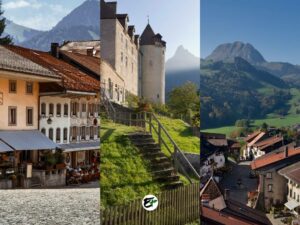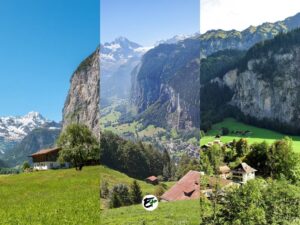10 Stunning Villages in The South of France (Worth Visiting)
The South of France is without a doubt one of the most beautiful regions in the world. Whether looking for a picturesque place, a breathtaking destination, or a romantic spot, southern France won’t leave you empty-handed.
If you’re planning to visit southern France, I suggest you add at least one of its charming towns or villages to your itinerary. The villages in the South of France are gems! Some look like they came out of a fairy tale, others are stunningly photogenic, and a few are rich in history and discoveries.
In this article, I share with you my 10 most beautiful villages in the South of France that will ignite your wanderlust! And trust me, if you’re looking for quaint, scenic, and romantic villages, this list has it all.
This post contains affiliate links. I may receive a tiny commission at no additional cost to you.

Use the table of contents to skip to topics.
Important: The catalogue is organized in an alphabetical sequence. After each village’s discussion, you’ll find a link that will lead you to another blog post for more insights about the village.
1. Aigues-Mortes

Let’s start the list of beautiful villages in the South of France with Aigues-Mortes—a fortified medieval city located within the wildlife-rich Camargue in the Gard department, Occitanie region. To me, Aigues-Mortes stands out as a beautiful village in southern France due to its medieval flair and the fascinating features that surround it, such as its medieval ramparts, extraordinary landscape, and rich wildlife.
Did you know that the ramparts of Aigues-Mortes were established back in the 13th and 14th centuries? What’s fascinating is that it was founded not just by a king, but also by a saint—Louis IX. Louis IX established Aigues-Mortes with the intention of creating a port city where he and his crusaders could gather before departing for the Holy Land.
Nestled within these ramparts is a church steeped in history. It is here that King Louis IX and his army are said to have received a bishop’s blessing before setting off from France.
Given its rich history, Aigues-Mortes is undoubtedly one of the most historic and beautiful villages in the South of France. Like, as you stand in awe of the fortifications of Aigues-Mortes, you can almost hear the echoes of thousands of knights and swordsmen marching through its grand medieval gates.
If you share my passion for architecture and history, you’ll find Aigues-Mortes to be a captivating destination. However, its location in Camargue, a river delta nestled between the two Rhone rivers, means that Aigues-Mortes offers more than just a glimpse into medieval architecture and history.
If you’re a nature enthusiast with a fondness for animals and beaches, Aigues-Mortes is sure to captivate you. A stroll along the ramparts offers a glimpse of the diverse attractions that await. From this vantage point, you can even catch sight of the Salins, a sea that shimmers in shades of pink – a truly unique spectacle!
What’s even more fascinating? As you approach the pink sea, you may catch sight of exotic wildlife seldom seen elsewhere. Among them are flamingos, whose elongated necks and legs make for an entertaining spectacle. But the flamingos aren’t the only inhabitants of Aigues-Mortes. You might also come across white horses and black bulls, animals that have been reared by the locals for centuries and have been integral to the region’s identity since the Middle Ages.
In close proximity to the beaches, you’ll discover the manades, where white horses and black bulls are nurtured. These places offer a fascinating insight into the culture surrounding these majestic creatures. If you’re feeling adventurous, you might even want to try your hand at horseback riding!
A wealth of delightful experiences await you in Aigues-Mortes and its surrounding area. I could easily pen another 1000 words to capture these enchanting moments, but that would transform this post into a novel. If Aigues-Mortes has sparked your curiosity and you’re eager to delve deeper, I suggest you peruse my detailed post about Aigues-Mortes.
2. Carcassonne
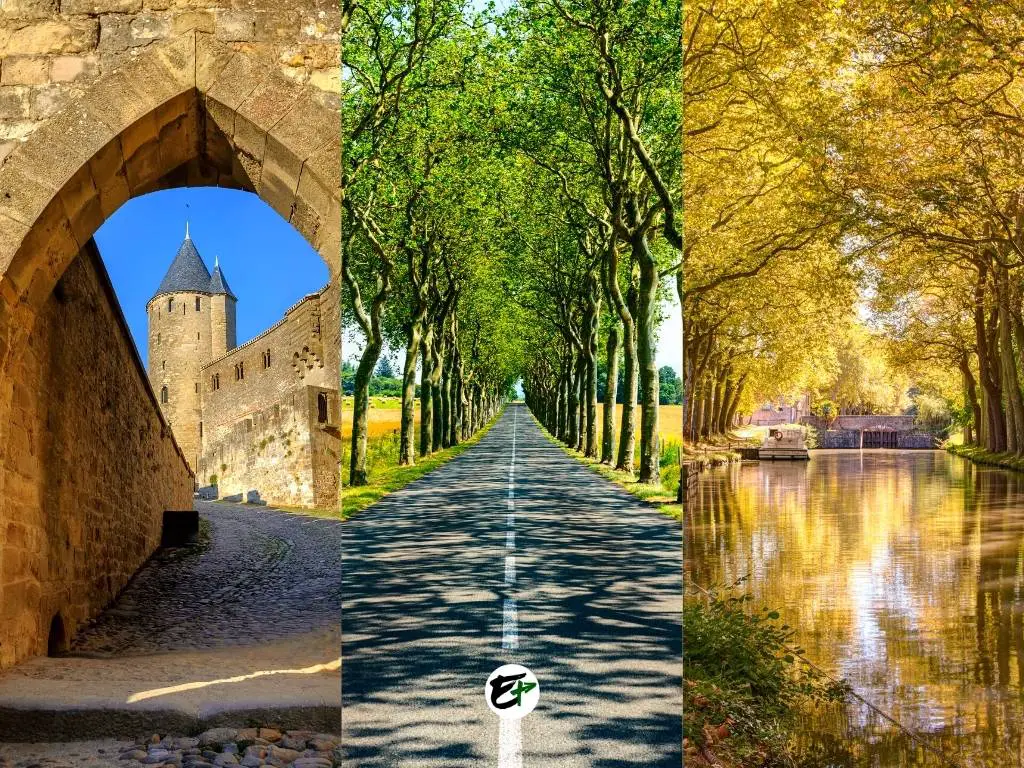
Prepare yourself for a journey back in time as you explore Carcassonne, a stunning walled medieval city nestled in the heart of southern France. This remarkable destination is undoubtedly one of the most picturesque villages in the region, offering a glimpse into the Middle Ages like no other.
Nestled just north of the Pyrenees, you’ll find Carcassonne, a charming commune in the Aude department of the Occitanie region. Its crown jewel is the Cite de Carcassonne, a perfectly preserved medieval village perched on a hill, offering sweeping views of the surrounding plains.
To me, having the chance to tread on the grounds of Carcassonne is an honor. More than just a charming village, Carcassonne is renowned as an unconquerable fortress by historians, following the completion of its fortifications. In bygone eras, it was a robust French frontier against what are now Spanish kingdoms. Not even the English could seize it despite their efforts. When you’ve been to Carcassonne, you can proudly claim to have visited one of France’s most historically important cities.
What is it about Carcassonne that captures the heart? It could be the awe-inspiring sight of its double-layered walls and towers, stretching over 3 kilometers. Whether you’re exploring from within or admiring from afar, these ancient structures have a way of transporting you back to the medieval era.
Prepare to be amazed by the medieval charm of Carcassonne. As you wander through the Cite de Carcassonne, you’ll encounter a stunning church, a castle, and even an open-air theater – quite the surprise! Be sure not to miss the Comtal Castle within the city. It’s home to exhibits that shed light on Carcassonne’s fascinating history. Plus, it offers the most breathtaking views of Carcassonne – so make sure it’s at the top of your list!
I often describe Carcassonne as a city of pairs. Why, you ask? Well, it’s not just the double-layered walls that make it unique. The city is divided into two distinct parts – the medieval district known as Cite de Carcassonne and the more modern Bastide Saint-Louis. Moreover, it boasts two UNESCO World Heritage Sites, adding to its charm.
The Cite de Carcassonne holds the honor of being the town’s first UNESCO site. Not far away, to the north of Bastide Saint-Louis, lies the Canal du Midi, another UNESCO gem. If exploration of the Cite de Carcassonne leaves you in need of a breather, make your way to the Canal du Midi. You can partake in a peaceful boat tour or hire your own boat for a leisurely sail along this picturesque waterway.
Have you ever wondered why Canal du Midi is recognized as a UNESCO World Heritage Site? It’s because this waterway is not just an engineering marvel that ignited the industrial revolution in the region, but also a testament to the artistic engineering skills that allowed it to harmonize with nature.
What’s more, it’s a vital link between the Mediterranean Sea and the Atlantic Ocean! As you navigate its waters, you’ll come across the ingenious lock systems that enabled small ships to traverse inland, journey through Europe, and emerge on different coasts.
Taking into account all that’s been mentioned, I wholeheartedly believe that Carcassonne deserves a spot on your travel itinerary. However, we’ve merely skimmed the surface of what Carcassonne has to offer. To fully appreciate the breadth of experiences available, I recommend reading my detailed article about Carcassonne. It’s packed with insights into the myriad of wonderful things you can enjoy in this historic city.
3. Chamonix

Of all the charming villages in southern France discussed in this post, Chamonix holds a distinct place. It is, without question, one of the most scenic spots you can encounter in France.
Nestled in a valley at the base of Mont Blanc, the highest peak in the Alps, lies the town of Chamonix. This unique locale, situated in the easternmost part of the Haute-Savoie department in the Auvergne-Rhône-Alpes region, has the distinction of being the only French town that shares its borders with both Italy and Switzerland.
In my opinion, Chamonix is a distinctive village in southern France becayse unlike other villages with their castles, fortifications, and quaint cobblestone lanes, Chamonix offers a different kind of beauty.
Chamonix is home to charming chalets, majestic mountains, serene lakes, and awe-inspiring glaciers – an alpine wonder that epitomizes the phrase ‘heaven on earth’! The picturesque scene of chalets adorned with flowers, surrounded by lush pine trees and framed by snowy mountains, is one of Chamonix’s most enchanting sights.
Should you visit Chamonix and have ample time on your hands, I highly recommend exploring the surrounding hamlets. Here, you’ll encounter the picturesque chalets bedecked with flowers that I’ve been raving about. These locales promise serene vistas that are sure to relax you. The invigorating mountain breeze, the sweet symphony of bird songs, and the rhythmic jingling of cowbells will provide a calming balm for your senses.
Journeying to Chamonix offers more than just the opportunity to unwind amidst France’s alpine countryside and its delightful chalets. Chamonix is a dream destination for many, boasting attractions that have earned it a spot on numerous bucket lists. Mont Blanc is the most prominent of these, but there’s more. You’ll also find Mer de Glace, the Alps’ second-largest glacier, right here in Chamonix. And believe it or not, you can even step inside this icy marvel!
While in Chamonix, don’t miss the chance to witness the additional glaciers visible from the town. Take a ride on the Aiguille du Midi cable car, one of the highest in the Alps and boasting the largest elevation gain, for the best views. The top station of this cable car is perched on a peak soaring 3,842 meters high. From here, you can soak in breathtaking panoramas of the French Alps, including the majestic Mont Blanc.
Aiguille du Midi offers an unforgettable experience with its small glass box room or terrace, aptly named the Aiguille du Midi Skywalk. Entering it gives you the sensation of stepping into thin air, with a clear view of the ground some 1,000 meters beneath your feet. It’s a heart-stopping moment that invites you to conquer your fears! And astonishingly, these adventures in Chamonix are just the tip of the iceberg when it comes to the fun you can have here.
If you’re acquainted with Chamonix’s geography, you’ll know that the attractions I’ve mentioned are nestled within the Mont Blanc massif. But there’s more to explore! On the other side of the Chamonix valley, opposite the Mont Blanc Massif, lies the Aiguilles Rouges Mountain Range. This area is brimming with activities and natural wonders. In my opinion, some of the best hiking trails in Chamonix can be found here.
Thanks to its position parallel to the Mont Blanc Massif, hikers can soak in unparalleled, unhindered, and breathtaking vistas of Mont Blanc. The hiking trails in the Aiguilles Rouges Mountain Range are dotted with ‘gems’. One such ‘gem’ is the mesmerizing alpine lakes, with Lac Blanc standing out as the most famous. On a clear day, you can see a reflection of the Mont Blanc massif shimmering on its surface. Keep your eyes peeled as you might also come across alpine animals on your hike.
I have a deep affection for the mountains, and there’s so much more about Chamonix that I’m eager to share with you. If you’re curious to uncover the full experience of a Chamonix trip, I suggest you take a look at my detailed post about Chamonix.
4. Domme

Southern France captivates with its heritage-rich and charming villages, each nestled in a picturesque setting. A prime example is Domme, fondly referred to as the “Acropolis of Perigord”. Situated in the Dordogne department of the Nouvelle-Aquitaine region in southwestern France, Domme offers a commanding view of the Dordogne valley from its cliff-top location along the meandering Dordogne River.
The story of Domme dates back to the 13th century when it was established as a bastide by Philip the Bold to protect his Dordogne territory. A bastide is essentially a medieval village built primarily for defense. These villages were typically fortified with walls, gates, towers, and bastions where guards were stationed for patrol. The houses in a bastide were arranged in a grid pattern, with streets intersecting at right angles.
A visit to Domme reveals its charm as a prime example of a bastide, and not just any bastide, but a truly beautiful one nestled in southern France. The quaint honey-colored houses, well-preserved over time, bear witness to this beauty. As you stroll through its streets, you’ll be captivated by the centuries-old buildings and vine-covered facades. The village’s old-fashioned restaurants further enhance its charm, promising an enjoyable experience!
What makes Domme even more intriguing? It’s the secret wonders that reveal themselves as you wander around the village. One such wonder is indeed hidden, but it’s remarkably simple to stumble upon. The first wonder lies beneath Domme – a cave, with its entrance situated right in the center of the village square. Without a doubt, this cave is a distinctive attribute of Domme that sets it apart.
Don’t miss the chance to explore the cave of Domme when you visit. This subterranean wonder is filled with fascinating rock formations and crystals. The tour concludes with a breathtaking view of the Dordogne Valley, offering you a two-in-one experience! From Domme’s lookout points, you might even catch sight of the Dordogne River bustling with kayakers and canoeists.
While taking in the view, the idea of sailing on the river might seem appealing. If such a thought occurs to you, you’re absolutely right! Spending time with nature is not only enjoyable, but there are also more attractions near Domme that you can discover when you sail on the Dordogne River. As you navigate the Dordogne River, you will encounter breathtaking cliffs, castles, and other picturesque villages.
Before you leave Domme for a sailing adventure on the Dordogne River, you might want to stop and enter Domme’s gate, La Porte des Tours. This gate houses mysterious graffiti created by Templar knights during their imprisonment. These graffiti are another hidden gem in Domme, their meanings still undefined and not fully understood to this day! Come and observe them, and perhaps speculate on what they might truly signify.
Most of the fun in Dordogne begins with Domme, especially if it’s the first place you visit. In addition to castles and more charming villages, a garden straight out of a fairy tale, known as Jardin de Marqueyssac, also awaits you in Dordogne.
To be honest, initially, I was under the impression that Domme might not be worth the visit for travelers coming from places far from Dordogne, especially if they’re practical travelers like myself. However, I was mistaken! The activities in Domme and its surroundings are fantastic. In fact, they’re so engaging that you might find it worthwhile to extend your stay in Domme or Dordogne for more than a day or two.
Do you want to learn more about Domme and its surrounding attractions in Dordogne? Read my detailed post about Domme.
5. Èze
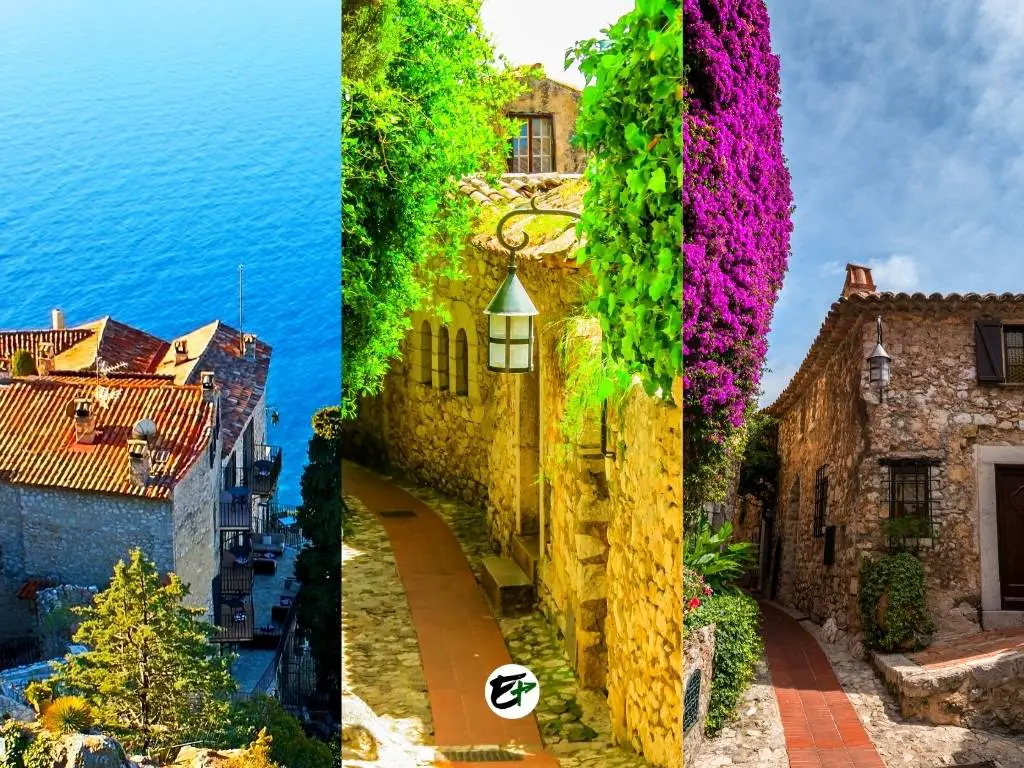
If you’re searching for a quaint, romantic village in the south of France, your search ends here in Eze. The dreamy vibe from Eze’s charming streets and scenic views is why a date or honeymoon in Eze is something you won’t forget!
So, where exactly is Eze? If you look at a map and zoom in on the coast of France in the Mediterranean, you’ll find it within the Provence-Alpes-Côte d’Azur region, specifically in the Alpes-Maritimes department. Eze is perched on a hilltop, nestled between the city of Nice and Monaco.
Perched atop a hill with a sweeping view of the French Riviera’s coast, Eze is undeniably one of the prime locations for a romantic sunset in the South of France. Picture yourself and your loved one in an Eze restaurant, gazing out at the Riviera’s coastline. There, you’re savoring wine and engaging in deep conversation. As the sun descends, the charming surroundings are bathed in a golden hue. You share a smile—surely, that’s a moment you’d want to freeze in time.
Indeed, Eze is a place where you can create beautiful and unforgettable moments. It’s not just for couples; whether you’re single or in a relationship, you’ll find Eze captivating. As you wander through its quaint narrow lanes and scenic gardens, you’ll feel as if you’ve stepped back in time.
The ivy-covered houses, flower-decked balconies, and stonemasonry-style buildings and arches create an atmosphere that’s far removed from the 21st century. If it’s a sunny day and you enjoy photography, be prepared to add more than a hundred new pictures to your collection after your visit to this medieval village.
The medieval village of Eze, with its charming compactness, can be explored in just an hour or two. However, that doesn’t mean your experience in Eze is limited to sightseeing and strolling through the village. If you’re interested, you can delve into the process of making perfumes and soaps. Are you a fan of the great outdoors? There are numerous ways to enjoy nature here. From hiking trails and mountains to beaches and a picturesque old fort, Eze offers a variety of refreshing outdoor activities.
After exploring the medieval village of Eze, your next stop is just a stone’s throw away. Located near the village parking lot, Parfumerie Fragonard L’Usine Laboratoire is an effortless detour. Here, you’ll delve into the world of perfume-making, discovering techniques that have been perfected by the Arabs over a thousand years.
For a deeper dive into Eze and all the exciting things you can do in the village, I recommend checking out my detailed post about Eze. It also offers a visual tour of the picturesque village and the breathtaking vistas of the French Riviera.
6. Gordes
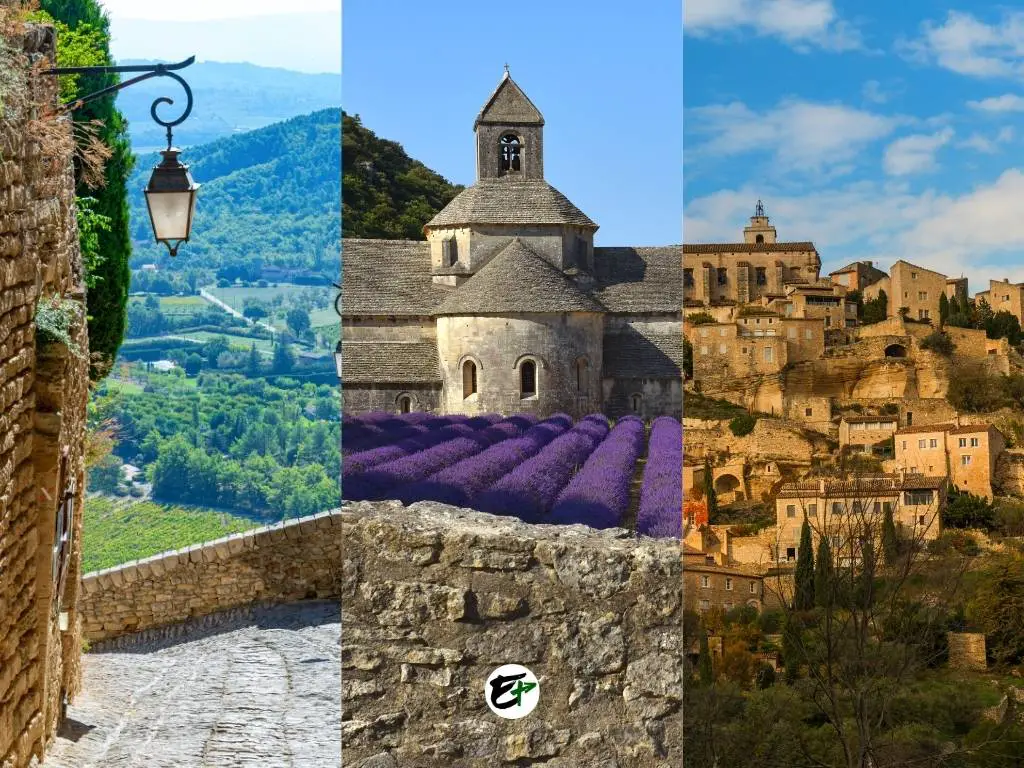
As we’ve seen with places like Eze and Domme, the villages in southern France are not just quaint, they’re visually stunning. Gordes is another such example. This medieval village, bathed in a warm caramel hue, is among the most photogenic places you’ll find in southern France. The allure of Gordes, whether viewed from within or from a scenic overlook, makes it a photographer’s dream!
Perched on a hill with a sweeping view of the Luberon Valley, Gordes is a sight to behold in the south of France. It’s one of the highlights of the Luberon Regional Nature Park, nestled in the Vaucluse department of the Provence-Alpes-Côte d’Azur region.
In my view, Gordes makes for an excellent destination for a couple of reasons. Firstly, it boasts a picturesque and enchanting village, offering the perfect escape, much like the other places mentioned in this post. Secondly, Gordes is home to captivating attractions near its medieval village that are perfect for capturing Instagram-worthy moments.
Stepping into the medieval center of Gordes is like taking a journey back in time. As you meander through its narrow lanes, lined with buildings that have stood for centuries, you’ll come across charming old-world fountains, artistic metal lanterns, and enchanting houses. With such captivating sights at every turn, you’ll find yourself constantly looking around as you stroll through this medieval village.
I must emphasize, don’t overlook what’s beneath your feet! Even the ground in certain parts of Gordes is a sight to behold, thanks to the “calades.” Essentially, calades are the South of France’s distinctive take on cobblestone.
Wondering where to find these calades in Gordes? The most stunning calades in Gordes can be found in the southern part of the village. They line Rue de Belvedere, just a few steps away from Eglise Saint-Firmin. Additionally, Rue de Belvedere serves as an excellent viewpoint for admiring the Luberon Valley.
While the scenic view of Luberon from Gordes is impressive, the panorama of Gordes from its roadside viewpoint is even more spectacular! Here, you can marvel at how the houses of Gordes seem to have been carved directly from the hill. The sight is particularly enchanting during sunset.
But your adventure doesn’t end in Gordes. After exploring the medieval village, be sure to visit the Village des Bories and Sénanque Abbey – two of the most captivating and picturesque attractions in the vicinity of Gordes.
Are you interested in witnessing astonishing houses constructed from stacked stones? You should definitely visit Village des Bories—a truly unique settlement. It’s essentially an open-air museum showcasing ancient stone huts! The creativity and skill of the initial settlers of Village des Bories never fail to amaze me. The sight of houses with concave ceilings made entirely of rocks will leave you pondering about their construction techniques.
What about Sénanque Abbey? This place is likely one of the most photographed abbeys in the world! A search for “Provence, France” on the internet will quickly reveal images of Sénanque Abbey, making it a true icon of Provence.
Its fame and allure for photographers stem from the lavender farm that flourishes beside it. But there’s more to Sénanque Abbey than just the lavender fields. It’s a place of tranquility and sanctity. Architecture enthusiasts will particularly appreciate the design of the cloister – it’s a must-see!
Interested in getting a sneak peek of Gordes, Village des Bories, and Senanque Abbey? Check out my comprehensive article about Gordes where you can explore these places and determine whether a visit to Gordes is worth your time.
7. Moustiers-Sainte-Marie

One of the delights of touring the South of France is the close proximity of its stunning attractions. The beautiful destinations in this region are practically neighbors, with some just a short car ride away from each other. Take for instance Moustiers-Sainte-Marie and the nearby tourist destinations in Alpes-de-Haute-Provence department and Provence-Alpes-Côte d’Azur region.
Nestled at the base of the mountains, you’ll find Moustiers-Sainte-Marie, a neighbor to these stunning attractions:
- The Valensole lavender fields — present a magical sight with their rolling landscapes seemingly draped in a plush purple carpet.
- Lake Sainte-Croix — the third largest artificial lake in France — is fed by mineral-rich waters from the Verdon Gorge and sparkles in an unreal turquoise color.
- The Verdon Gorge — akin to France’s Grand Canyon with its striking rock formations and deep gorges.
While these tourist destinations in the South of France are must-see attractions themselves, one cannot overlook Moustiers-Sainte-Marie as one of the focal points of a trip to the Provence-Alpes-Côte d’Azur region.
Moustiers-Sainte-Marie exudes a unique charm that sets it apart from other villages, particularly when admired from afar. The picturesque village nestled against the backdrop of limestone mountains presents an absolutely breathtaking view.
It is a spectacle that is especially mesmerizing at sunset! As the village and the mountains face west, the setting sun casts a direct, golden glow on Moustiers-Sainte-Marie and the mountains behind it. This golden view is a sight you wouldn’t want to miss on your visit to southern France.
Wandering around the village, you’ll encounter charming old-world fountains, houses adorned in pastel hues, and squares that beg to be captured on camera. The local shops offer a glimpse into the age-old craft of faience making that the village is known for.
Look up from the streets of Moustiers-Sainte-Marie and you’ll see something twinkling above – it’s the village star, a symbol synonymous with Moustiers-Sainte-Marie. This star, hanging high above and tethered to the neighboring mountains, lends an extra touch of uniqueness to Moustiers-Sainte-Marie. And of course, there’s a captivating legend associated with it!
Should you wish, you can venture closer to the star. Nestled in the mountains near the star is a pilgrimage church, Notre-Dame-de-Beauvoir, which you can reach on foot from the village. The journey to Notre-Dame-de-Beauvoir is a scenic one! In its vicinity, you’ll be greeted with awe-inspiring views of Verdon Regional Nature Park. The vistas encompass Lake Sainte-Croix, expansive lush forests, and the verdant fields of the nature park.
The view of Lake Sainte-Croix from the church’s viewpoint is undoubtedly beautiful, but don’t limit your experience to just that. Venture out and experience Lake Sainte-Croix in all its beauty, teeming with exciting water sports, awe-inspiring vistas, and picture-perfect spots. And if you’re feeling adventurous, why not paddle your way to Verdon Gorge in a kayak, canoe, or boat? It’s an unforgettable journey that awaits you!
If you’re interested in delving deeper into the history and charm of this village, I’ve written a detailed article on Moustiers-Sainte-Marie. In it, I’ve covered everything from the legend of the village’s star to the captivating Verdon Gorge, the serene Lake Sainte-Croix, and the enchanting Valensole lavender fields.
8. Rocamadour
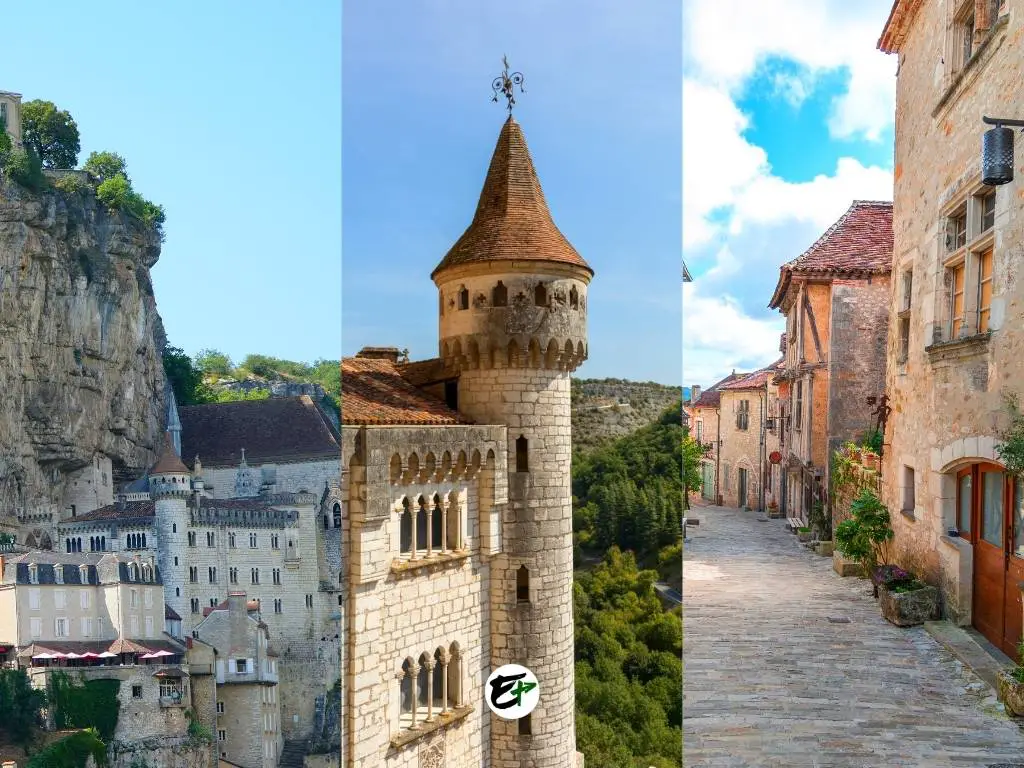
Have you heard about a charming village in Southern France that was a popular destination even before the rise of the tourism industry? It’s called Rocamadour, and it’s now the second most visited village in France, right after Mont-Saint-Michel. Back in the Middle Ages, Rocamadour was a significant pilgrimage site for Christians.
Today, Rocamadour is recognized as part of a UNESCO site known as the “Routes of Santiago de Compostela in France.” Nestled in the southwestern part of France, within the Lot department of the Occitanie region, this village clings to the cliff walls of the Alzou Valley.
Why is Rocamadour considered a gem in southern France? The answer lies in the timeless beauty of its medieval village. The stone-built houses with their Lauze-style roofs, the cobblestone streets, the ancient gates, the cliff-top castle, and the fortified sanctuaries all paint a picture of a bygone era. Rocamadour is truly a marvel that leaves no room for dispute.
As an engineer with a background in science, I find it intriguing how the residents of Rocamadour managed to construct their medieval village on a cliff wall. It makes me wonder; how did they ensure the stability of the structures, particularly the sanctuaries?
But, is Rocamadour’s beauty the sole reason for its popularity among millions of visitors? Maybe that’s true today. But centuries ago, it was the Black Madonna, a miraculous figure of the Virgin Mary, that drew people in.
Legend has it that this figure was carved from walnut wood by Saint Amadour, a hermit who was among the first to spread the gospel in Quercy. One of the miracles associated with Rocamadour is the discovery of Saint Amadour’s uncorrupted body in front of the chapel of the Black Virgin. A visit here is like joining an age-old pilgrimage, one that was even followed by kings and queens during the Middle Ages.
But Rocamadour offers more than just religious and architectural experiences; it’s also a gateway to stunning landscapes. Like Moustiers-Sainte-Marie, Rocamadour is nestled within a natural park (Causses du Quercy Natural Regional Park) where natural beauty and diverse wildlife await exploration.
Imagine you’re standing in the sanctuaries of Rocamadour. Just a short walk away, you’ll find the Rocher des Aigles, a place where you can not only see majestic birds but also watch them perform! Right next to Rocher des Aigles is Parc Durandal, a medieval-themed park.
Here, you can enjoy equestrian shows and plays set in the Middle Ages. If you’re a fan of series or movies like Merlin (2008), you’ll find their performances quite captivating. They perform in French, but the storyline is easy enough to follow.
Rocamadour has so much more to offer that we’ve barely begun to explore! I recommend delving deeper into its wonders through my comprehensive post about Rocamadour. This detailed guide will serve as a valuable resource when you plan your visit to the village.
9. Saint-Cirq-Lapopie

Just a few kilometers south of Rocamadour, the charming village we’ve been talking about, lies Saint-Cirq-Lapopie. This is another delightful village in southern France that was chosen as the country’s favorite village in 2012. Saint-Cirq-Lapopie sits high on a rocky cliff, overlooking the beautiful Lot valley and river. On a broader scale, it’s located within the Lot Department in the Occitanie Region of southwestern France.
Like many villages featured in this post, Saint-Cirq-Lapopie is both charming and scenic. But what truly distinguishes it is the unique architecture of its buildings, crafted in stone masonry and half-timbered style.
From the valley below, along the Lot river, Saint-Cirq-Lapopie is barely visible. The only structure that stands out is the village church. But as you approach the old entrance gates of Saint-Cirq-Lapopie, particularly at Porte de Rocamadour, the scene changes dramatically! The view from Porte de Rocamadour is picture-perfect, transporting you back in time.
With no cars in sight and lush green surroundings, the village seems to merge seamlessly with the cliff’s earthy tones. It’s like stepping into a fairytale. You might feel like a medieval wanderer who has discovered a hidden gem on their journey.
The medieval charm of Saint-Cirq-Lapopie becomes more pronounced as you delve deeper into the village. The stone buildings, some draped in vines, the cobblestone paths, half-timbered houses, and quaint souvenir shops all contribute to a sense of adventure. Don’t miss the chance to climb to the village’s highest point, where the old castle of Saint-Cirq-Lapopie once stood.
Even though the castle of Saint-Cirq-Lapopie no longer stands, the panoramic view from its ruins over the village and the Lot Valley can make you feel as if it’s still there. From this vantage point, you can see the streets, squares, and almost every corner of the village. The sight might make you feel like a medieval guard stationed in a castle, keeping watch over the commune.
The beauty of the landscape around Saint-Cirq-Lapopie is undeniable, and it’s even more breathtaking from the hiking trails that branch out from the village.
One trail that stands out is the towpath that connects Saint-Cirq-Lapopie and Bouziès. This path was once a vital route for transporting goods along the Lot River. Today, however, it no longer serves this purpose. Instead, it has transformed into a tourist attraction, offering visitors a chance to explore artwork, waterway mechanisms, scenic railroads, and more.
If hiking isn’t your thing, you can still enjoy the sights along the Lot River or towpath by taking a ride on a traditional boat known as a Gabare. As you glide along the water, you can sit back and observe the workings of a canal lock. The boat operators often have activities planned that can be both entertaining for children and informative for adults.
Has Saint-Cirq-Lapopie piqued your interest? I invite you to explore my detailed blog post about Saint-Cirq-Lapopie. There, you’ll find a showcase of the stunning views and attractions that surround the village.
10. Saint-Paul de Vence

Finally, let’s not forget about the picturesque village in the South of France that feels like a museum housing even more museums. It’s known as Saint-Paul-de-Vence, a well-preserved medieval walled village that’s a haven for art lovers.
In Saint-Paul-de-Vence, art is omnipresent. It permeates the streets, the homes, the objects inside the buildings, and even the lives of those who reside there.
Wondering where to find Saint-Paul-de-Vence? This gem is nestled in the French Riviera, just a 30-minute drive from Nice. In my opinion, it’s a must-visit destination in the Alpes-Maritimes department, which is part of the Provence-Alpes-Côte d’Azur region in southeastern France.
Saint-Paul-de-Vence, similar to other beautiful villages in southern France, is situated atop a hill. This location gives it a unique charm and provides scenic views. It’s also a place for romance, with its flower-patterned calades, houses covered in flowering vines, and spectacular views that create the perfect setting for a proposal, unforgettable date, or honeymoon.
Interestingly, the locals have been practicing the art of winemaking for several centuries, promising an enhanced wine-tasting experience during your stay.
Without a doubt, Saint-Paul-de-Vence is a place where beautiful memories can be made. If you plan to visit, don’t miss the chance to admire the unique artworks scattered throughout the village! Many of these pieces showcase innovative art techniques that are truly one-of-a-kind. Even a simple stroll around the village will reveal numerous works of art, no gallery admission required.
Make sure to visit Place de Gaulle when you need to rest and refresh. It’s a popular spot where locals and tourists alike enjoy playing Petanque, a local game that’s quite captivating to watch. The objective of the game is to throw one ball towards another. And guess what? You can join in on the fun too! Just head over to the tourism office and ask about the upcoming games. They’ll guide you on how to play Petanque.
The art journey doesn’t stop within the medieval confines of Saint-Paul-de-Vence. Just a few steps from the entrance of this walled village, you’ll find the Maeght Fondation, home to an impressive collection of 12,000 modern art masterpieces. Each year, over 200,000 visitors flock here to marvel at the art! And it’s no surprise why – the Maeght Fondation boasts the largest collection of 20th-century art in Europe.
If you find yourself with some extra time, consider exploring the great outdoors in Saint-Paul-de-Vence. The village is surrounded by cycling and hiking trails that offer a chance to connect with nature. And don’t forget to bring a good camera if you plan on hiking! The trails offer stunning views of Saint-Paul-de-Vence, which are particularly breathtaking during the golden hour.
There’s no shortage of charming locations and fascinating finds in Saint-Paul-de-Vence. For a more in-depth look at what the village has to offer, I recommend reading my detailed post about Saint-Paul-de-Vence.
So there you have it! These are my top picks for the most beautiful villages and towns in southern France. Aren’t they just quaint, scenic, and romantic? I’d love to hear which place captured your heart the most. Feel free to share your thoughts in the comments below!
Thank you for taking the time to read this, and I wish you nothing but the best on your travels! If you’re considering a city to visit in France, I have a few strong recommendations:
- Paris: Experience the romantic allure of the “City of Love”, with its enchanting streets, cozy cafes, and iconic landmarks like the Eiffel Tower.
- Reims: Dive into history at Reims, the coronation site of French kings and queens, and explore the world-renowned Champagne houses.
- Strasbourg: Immerse yourself in a blend of French and German culture, admire unique architecture, and explore the rich history of the unofficial capital of Champagne.
- Colmar: Discover the charm of Colmar in the Alsace area, known for its picturesque canals and rich history.
- Lyon: Savor the gastronomic delights in Lyon, known as the food capital of France, and enjoy a mix of old and new attractions amid stunning architecture.
- Avignon: Experience a rich Christian heritage in Avignon, famous for its historic bridge and many other marvels.
Save it on Pinterest.







